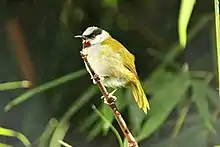Grey-capped warbler
The grey-capped warbler (Eminia lepida) is a species of bird in the Cisticola family Cisticolidae. It is the only species in the genus Eminia. The grey-capped warbler is found in Burundi, Democratic Republic of the Congo, Kenya, Rwanda, South Sudan, Tanzania, and Uganda. Is a large, chunky, thin-tailed- warbler with a distinctive grey cap, black band that's around its head, and a chestnut throat wrapping its neck. They maintain a diet of insects and other invertebrates, including caterpillars, moths, grasshoppers, mantids, etc.
| Grey-capped warbler | |
|---|---|
 | |
| In East Africa | |
| Scientific classification | |
| Kingdom: | Animalia |
| Phylum: | Chordata |
| Class: | Aves |
| Order: | Passeriformes |
| Family: | Cisticolidae |
| Genus: | Eminia Hartlaub, 1881 |
| Species: | E. lepida |
| Binomial name | |
| Eminia lepida Hartlaub, 1881 | |
Identification 15 cm; 16–24 g. A large, chunky, thin-tailed warbler with distinctive grey cap, a black band around head and chestnut throat; rump feathers long and lax. Cheek, neck, and underparts are grey, tinged olive-green on flanks and undertail-coverts; most have chestnut vent patch; upperparts, tail and median and greater upper wing-coverts olive-green, lesser coverts and underwing-coverts chestnut; flight-feathers dark brown, edged olive-green; iris reddish-brown; bill and mouth black; legs pinkish-brown. Sexes alike. Juvenile is duller than an adult, with smaller, paler throat patch and brown eyes, when recently fledged has prominent yellow gape and shorter tail. Its natural habitat is subtropical or tropical moist shrubland.
Habitat Dense undergrowth, scrub, and creepers, usually in damp areas along forest edges, seeps, or riparian strips; also well-planted gardens. Confined to areas with annual rainfall exceeding 500 mm. Usually above 800 m; to 2500 m in Kenya. Movement is Sedentary.
Diet and Foraging Diet insects and other invertebrates, including caterpillars and moths (Lepidoptera), grasshoppers (Orthoptera), mantids (Mantodea), spiders (Araneae), and millipedes (Diplopoda). Forages by gleaning from foliage and bark, actively searching among dead, curled-up leaves, crevices in bark, and holes in twigs. Secretive; skulks among dense vegetation, easily overlooked if not singing. Joined a large variety of frugivorous and insectivorous species attracted to stand of fruiting Euclea Divinorum trees in Tanzania.
Sounds and Vocal Behavior Male song, from exposed perch, mainly during the breeding season, a loud, varied series of trills and whistles, lasting 6–20 seconds, typically containing a number of repeated elements, song uttered every c. 30 seconds; female utters dry trill with up to 7 notes per second, usually during the male song, in poorly developed duet. Male also utters trilling call; alarm a soft “pree”, or louder scolding calls when agitated.
Breeding Breeds during rains; Mar-Jun and Oct–Nov in Sudan and DRCongo, Apr-May in Uganda, and May–Aug and Nov–Jan in Kenya; multiple broods attempted. Probably monogamous, partners apparently remain together throughout the year; solitary, territorial. When singing together, partners sit close together or hop around each other, with throat feathers raised and tail fanned and erect; once duet ends, male bends forward, holding long back, rump, and flank feathers raised in the manner of a puff back (Dryoscopus). Nest built by both sexes, male sometimes calls while female builds, construction of one nest took 2 weeks; an untidy, ball-shaped structure, side entrance with protruding porch (up to 8 cm long) and platform (2·5 cm), made of long strips of fibrous vegetation and leaves, woven together and lined with moss, spider web, rootlets, feathers and plant down, suspended from thin branch or creeper inside dense vegetation, once slung between two saplings, usually, 1–3 m (rarely 5 m) up, often over water, where it resembles debris lodged in the overhanging branch; nest sometimes re-used in successive seasons; one record of weaver (Ploceidae) nest being used after entrance modified and long, trailing vegetation added to enhance camouflage. Clutch 2–3 eggs; incubation mainly by the female, period 12–13 days; chicks fed by both sexes, the male often passing food to female and she then feeding nestlings, both also remove feces, dropping them some distance from the nest; fledging period c. 16 days; adults accompany fledglings, call loudly if approached. Breeding success low, average only 0·27 broods/pair/year in Kenya (multiple attempts during protracted breeding season); some streamside nests destroyed by floodwaters.
References
- BirdLife International (2017). "Eminia lepida". The IUCN Red List of Threatened Species. IUCN. 2017: e.T22713847A118723363. doi:10.2305/IUCN.UK.2017-3.RLTS.T22713847A118723363.en. Retrieved 15 December 2017.
- Ryan, Peter (2006). Family Cisticolidae (Cisticolas and allies). pp. 378–492 in del Hoyo J., Elliott A. & Christie D.A. (2006) Handbook of the Birds of the World. Volume 11. Old World Flycatchers to Old World Warblers Lynx Edicions, Barcelona ISBN 978-84-96553-06-4
- Nguembock B.; Fjeldsa J.; Tillier A.; Pasquet E. (2007): A phylogeny for the Cisticolidae (Aves: Passeriformes) based on nuclear and mitochondrial DNA sequence data, and a re-interpretation of a unique nest-building specialization. Molecular Phylogenetics and Evolution 42: 272–286.
- Ryan, P. (2020, March 04). Gray-capped Warbler (Eminia lepida). Retrieved October 16, 2020, from https://birdsoftheworld.org/bow/species/gycwar3/cur/introduction
- Canto. (1881). Retrieved October 16, 2020, from https://www.xeno-canto.org/species/Eminia-lepida
- Gray-capped Warbler- Eminia lepida. (2003). Retrieved October 16, 2020, from https://avibase.bsc-eoc.org/species.jsp?avibaseid=31E5F1E9921CF416
